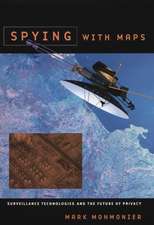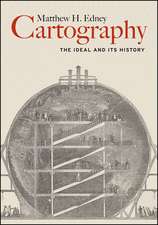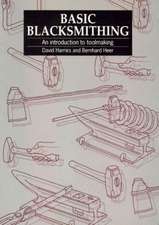Medieval Islamic Maps: An Exploration
Autor Karen C. Pintoen Limba Engleză Hardback – noi 2016
Hundreds of exceptional cartographic images are scattered throughout medieval and early modern Arabic, Persian, and Turkish manuscript collections. The plethora of copies created around the Islamic world over the course of eight centuries testifies to the enduring importance of these medieval visions for the Muslim cartographic imagination. With Medieval Islamic Maps, historian Karen C. Pinto brings us the first in-depth exploration of medieval Islamic cartography from the mid-tenth to the nineteenth century.
Pinto focuses on the distinct tradition of maps known collectively as the Book of Roads and Kingdoms (Kitab al-Masalik wa al-Mamalik, or KMMS), examining them from three distinct angles—iconography, context, and patronage. She untangles the history of the KMMS maps, traces their inception and evolution, and analyzes them to reveal the identities of their creators, painters, and patrons, as well as the vivid realities of the social and physical world they depicted. In doing so, Pinto develops innovative techniques for approaching the visual record of Islamic history, explores how medieval Muslims perceived themselves and their world, and brings Middle Eastern maps into the forefront of the study of the history of cartography.
Pinto focuses on the distinct tradition of maps known collectively as the Book of Roads and Kingdoms (Kitab al-Masalik wa al-Mamalik, or KMMS), examining them from three distinct angles—iconography, context, and patronage. She untangles the history of the KMMS maps, traces their inception and evolution, and analyzes them to reveal the identities of their creators, painters, and patrons, as well as the vivid realities of the social and physical world they depicted. In doing so, Pinto develops innovative techniques for approaching the visual record of Islamic history, explores how medieval Muslims perceived themselves and their world, and brings Middle Eastern maps into the forefront of the study of the history of cartography.
Preț: 413.89 lei
Nou
Puncte Express: 621
Preț estimativ în valută:
79.20€ • 82.91$ • 65.53£
79.20€ • 82.91$ • 65.53£
Carte disponibilă
Livrare economică 17-31 martie
Livrare express 28 februarie-06 martie pentru 76.28 lei
Preluare comenzi: 021 569.72.76
Specificații
ISBN-13: 9780226126968
ISBN-10: 022612696X
Pagini: 384
Ilustrații: 162 color plates
Dimensiuni: 178 x 254 x 33 mm
Greutate: 1.59 kg
Ediția:1
Editura: University of Chicago Press
Colecția University of Chicago Press
ISBN-10: 022612696X
Pagini: 384
Ilustrații: 162 color plates
Dimensiuni: 178 x 254 x 33 mm
Greutate: 1.59 kg
Ediția:1
Editura: University of Chicago Press
Colecția University of Chicago Press
Notă biografică
Karen C. Pinto is assistant professor of Islamic and Middle Eastern history at Boise State University.
Cuprins
Note on Transliteration
Chapter 1 Introduction: Ways of Seeing Islamic Maps
Chapter 2 A Look Back
Chapter 3 A Sketch of the Islamic Mapping Tradition
Chapter 4 KMMS World Maps Primer
Chapter 5 Iconography of the Encircling Ocean
Chapter 6 Classical and Medieval Encircling Oceans
Chapter 7 The Muslim Baḥr al-Muḥīṭ
Chapter 8 The Beja in Time and Space
Chapter 9 How the Beja Capture Imagination
Chapter 10 Meḥmed II and Map Patronage
Chapter 11 The KMMS Ottoman Cluster
Chapter 12 Source of the Ottoman Cluster
Chapter 13 Conclusion: Mundus est immundus
Acknowledgments
Notes
Bibliography
Index
Chapter 1 Introduction: Ways of Seeing Islamic Maps
Chapter 2 A Look Back
Chapter 3 A Sketch of the Islamic Mapping Tradition
Chapter 4 KMMS World Maps Primer
Chapter 5 Iconography of the Encircling Ocean
Chapter 6 Classical and Medieval Encircling Oceans
Chapter 7 The Muslim Baḥr al-Muḥīṭ
Chapter 8 The Beja in Time and Space
Chapter 9 How the Beja Capture Imagination
Chapter 10 Meḥmed II and Map Patronage
Chapter 11 The KMMS Ottoman Cluster
Chapter 12 Source of the Ottoman Cluster
Chapter 13 Conclusion: Mundus est immundus
Acknowledgments
Notes
Bibliography
Index
Recenzii
"Through excellent research in multilingual (Arabic, Persian, and Turkish) primary and secondary resources, Pinto provides a significantly original, detailed, and compelling in-depth assessment of medieval Islamic cartography from the mid-10th to the 19th century. The author focuses on a ninth-century tradition of maps known collectively as the Kitab al-Masalik wa al-Mamalik, or Book of Roads and Kingdoms, by the Persian geographer Ibn Khordadbeh, and Greek history (notably Ptolemy) from the perspectives of iconography, context, and patronage. In 13 chapters augmented by 150 superb (mostly color) illustrations, 741 scholarly notes, and 686 bibliographic references, she examines these Muslim maps as documents of political and cultural history from a broad humanities context and demonstrates the intersection with Western cartography. Tracing the inception and evolution of these maps, Pinto analyzes them to uncover the identities of their creators, painters, and patrons. Incredibly valuable for research in cartography, historiography, and Islamic studies.This unique compendium is a 'must acquisition for scholars and major libraries. Essential."
"Pinto's book is well-researched and provides a number of excellently reproduced, beautiful illustrations. One must be grateful for her extensive library research and the photographs she has made of rare world maps that are normally hard to see. The University of Chicago Press has done a magnificent job with the illustrations."
“Medieval Islamic Maps is a project of great value and importance: it uses maps as documents of political and cultural history and relates them to changes in other arts. Pinto displays profound knowledge of her sources, excellent contextual awareness, indefatigable scholarship, a keen eye for evidence, suppleness in thought, and fluency in expression. She situates her maps against intercultural influences, political circumstances, and agendas of mapmakers and patrons. Her approach is markedly original compared with existing works, which tend to focus on the technical aspects of cartography. Reading Medieval Islamic Maps is a rich and rewarding experience, and any scholar interested in Islam, cartography, or historiography should take notice of this fine work.”
“Written with a clear and compelling voice, Medieval Islamic Maps illuminates the history and significance of centuries of medieval Islamic cartography. Pinto includes an abundance of fascinating maps throughout, coaxing the reader into a thorough understanding of them through her use of a Google Earth distortion. One of the most fascinating themes of the book, which shows both depth and breadth, is Pinto’s demonstration of how the KMMS mapping tradition—the most widely circulating and longest living cartographic template—became more stylized and less representative over the centuries to finally emerge as an objet d’art. She does this while simultaneously tracing how it intersected with the Western cartographic tradition in one of its afterlives. With a gradual development of her arguments in short, concise chapters, Pinto offers an absorbing—and much-needed—exploration of Middle Eastern cartography that will be an essential addition in the next textbook on Islamic history.”
“In Medieval Islamic Maps, Pinto makes an underappreciated and misunderstood genre of historical source very accessible and understandable. Drawing impressively on Arabic, Ottoman, and Persian sources, she guides the reader through key issues relating to their interpretation, and situates them in their cultural, historical, and geographical contexts. It is a work of great originality and importance.”
"Books on Islamic maps can be counted on the fingers of one hand, and this volume is a very important addition to a fledgling field."
"Pinto’s analysis shows how KMMS maps can be used as alternate gateways into the Islamic history of cartography. It is stimulating to see how this corpus of maps, until now largely neglected—unlike Ptolemaic cartography and its later developments—and considered of little significance to the study of the history of science, is now considered as relevant material for cartographic and historical studies."
"The book is lavishly illustrated; most maps are reproduced in high-quality color copy, many photographed by the author. Some maps are made available in print for the first time....Pinto is painstaking with regard to visual details of map ideography and decoration, while expressing hope that art historians will turn their attention to illustrations in scientific manuscripts (248). Her work is both meticulous and imaginative – truly an exploration."
"The book is well written and easy to folow. The research is excellent ...What really stands out in her volume are the illustrations... I certainly recommend this work and believe it is a strong entry into a history of medieval maps.
"[Pinto] traces the development of Islamic mapping traditions alongside the cosmographic and cartographic descriptions of the cultures, including Hindu, Buddhist and Jain, that influenced those styles...This volume explores maps as gateways into Islamic history offering insights that can be appreciated by both scholars and general readers."
"This is a necessary book for research libraries and, as noted, a good supplementary read for instructors covering geographies of the Middle East through time."





















